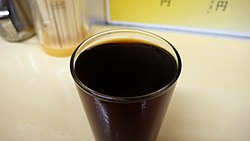Huangjiu
| Huangjiu | |||||||||||

A glass of Shaoxing wine, a variety of huangjiu
|
|||||||||||
| Traditional Chinese | |||||||||||
|---|---|---|---|---|---|---|---|---|---|---|---|
| Simplified Chinese | |||||||||||
| Hanyu Pinyin | huángjiǔ | ||||||||||
| Literal meaning | yellow wine | ||||||||||
|
|||||||||||
| Transcriptions | |
|---|---|
| Standard Mandarin | |
| Hanyu Pinyin | huángjiǔ |
| Southern Min | |
| Hokkien POJ | hông-chiú |
Huangjiu, translated as yellow wine, is a type of Chinese alcoholic beverage made from water, cereal grains such as rice, sorghum, millet, or wheat and a jiuqu starter culture. Unlike baijiu, such liquors are not distilled and contain less than 20% alcohol. Huangjiu is usually pasteurized, aged, and filtered before their final bottling for sale to consumers. Some styles are aged for as much as 20 years and sold as premium products. The various styles of huangjiu may vary in color from clear to beige, yellowish brown, or reddish brown. Many famous Huangjiu brands are noted for the quality of water involved in the brewing process, and some consider it to be the most important ingredient.
Huangjiu is either drunk directly after being cooled or warmed, or used in Chinese cooking. Major producers of huangjiu include mainland China and Taiwan.
Archaeology has established that ancient China brewed beer, although this fell later completely out of favor until the modern age. In its place, various "wines" were invented. The earliest was supposedly devised by Dukang during the reign of Shaokang of the Xia. Dukang was subsequently deified as the Chinese god of wine. His son Heita is sometimes said to have accidentally invented Chinkiang vinegar when his forgetfulness allowed a vat to spoil.
Huangjiu are classified based on several factors. Among them are the liquor's dryness, the starter used in its production, and its production method.
This is the formal classification for all Chinese wines. There are five categories: dry, semi-dry, semi-sweet, sweet, and extra-sweet.
...
Wikipedia
